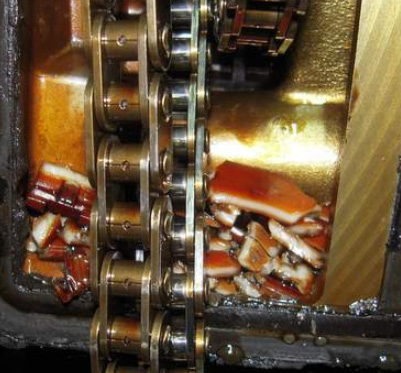
DIAGNOSING THE CHICKEN AND THE EGG
Sometimes a failure or even a comeback seem obvious and we point a finger at a failure point and assume that it was defective. A little investigating might show a cause and effect scenario and what might be thought of as defective or failing may not have been able to operate properly from the start. — This is never more true then in the case of timing tensioners. Most tensioners are simple oil pressure operated pistons. But if they pick up any debris and are not getting full oil pressure they cannot function properly. They may not be able to keep up with engine RPM and timing chain motion. — Bring us to the failed chain guide. Just because these parts are made of plastic does not make them weak. When timing chain tension is maintained, guides should last a long time. If a guide is broken it has taken a impact, usually from a timing chain running out of control. – Other timing components such as cam phasers can also cause failures in other components. A failed phaser or the controls for the phaser can greatly affect cam timing. If the camshaft shaft moves to far valves can and will come in contact with the pistons. Replace the valves, but make sure the cause of the failure is repaired or replaced. — Camshaft failure is often blamed on bad cams. This is rarely if ever the case anymore. Manufacturers are aware of this and cams are checked well before they get out of the factory door. More likely camshaft failure is do to either a lubrication problem or a lifter that cannot rotate or has stopped rotating. Lifter to bore clearance needs to be tight for hydraulic lifters to work properly. It does not take much debris to come between lifter and block. Even camshaft assembly grease that gets up the side of the lifter might stop rotation. And if an engine does not start quickly and come up to fast idle quickly, lubrication can be wiped from the lubes and a lack of lubrication will hurt the new cam. — Lifter internal clearance is very tight, as tight as .0005” in some performance lifters. Any debris, even lint from a rag is larger than this and may cause a problem. This is very true for activating lifters for GM AFM systems which act as a lifter within a lifter. A faulty AFM controller may starve lifters of the oil pressure they need to operate correctly and will cause a lifter to lock up. The lifter was not defective, it was not under control and following the camshaft while in open position. The abuse it takes will lock it into open position. This may also cause mechanical failure to cam and lifter. And do not forget that the lifter buckets are designed to direct oil into the lifter and and too much clearance may cause a loss of oil pressure to the lifter. — Many systems must operate in perfect harmony within modern engines. If one fails, don’t forget to look deep for the cause. Just replacing a part may allow it to happen again.
Engine Pro Technical Committee
November, 2018